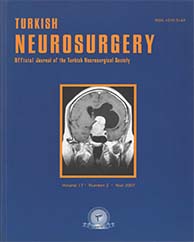2,3Dicle University, Department of Neurosurgery, Diyarbakır, Turkey
4Dicle University, Department of Pathology, Diyarbakır, Turkey OBJECTIVE: Biochemical and radiological properties of sellar and parasellar lesions are quite similar in some instances. This leads to a difficulty in preoperative diagnosis. Here, a pituitary adenoma and a suprasellar arachnoid cyst in the same patient is presented, and possible etiopathogenetic mechanisms and surgical treatment are discussed.
CASE: A56-year-old male patient was admitted to the hospital with a history of seizures, urinary incontinence and visual disturbances. Preoperative MRI revealed a mass lesion in the sella turcica with suprasellar extension and a coexisting large supra- and parasellar cyst.
DISCUSSION and CONCLUSION: A slow-growing mass lesion beneath the defective mesencephalic leaf of the Liliequist membrane may lead to a one-way valve system on its surface. It might be speculated that CSF will become trapped in the cyst during tumor growth. The other possible mechanism to explain the coexistence is discussed. In light of these comments and intraoperative observations, we suggest a third type of suprasellar arachnoid cyst. a semicommunicative type.
Keywords : Membrane of Liliequist, Parasellar mass, Pituitary adenoma, Sellar mass, Suprasellar arachnoid cyst




